TRON Industry Weekly Report: Trade War Comes to an End but the Federal Reserve Takes a Hawkish Stance, BTC Staking Yields Attract Attention
# I. Outlook
## 1. Macroeconomic Summary and Future Predictions
Affected by the uncertainty of tariff policies, the U.S. stock market has experienced extreme volatility, with the S&P 500, Dow Jones, and Nasdaq indices all declining. Over the past week, the Dow fell by 2.66%, the Nasdaq by 2.62%, and the S&P 500 by 1.50%, leading to a cautious market sentiment. The tariff war remains a core factor influencing the market. Although the U.S. has postponed new tariffs on some countries, high tariffs on China continue to exert pressure, with multiple countries actively seeking negotiations to ease trade tensions. The U.S. stock market is experiencing significant fluctuations under the uncertainty of tariffs and concerns about the economic outlook, showing an overall downward trend, with reduced market risk appetite. In the short term, further adjustment risks should be monitored.
## 2. Market Changes and Warnings in the Crypto Industry
Last week, the crypto market did not follow the U.S. stock market's decline under the dual impact of macro trade policy fluctuations and the collapse of certain tokens, showing a volatile upward trend but with considerable risks. Bitcoin performed relatively well, while mainstream coins showed differentiated volatility, and confidence in altcoins was significantly damaged. Frequent mergers and collaborations within the industry indicate that institutions still view the long-term potential of crypto assets positively. Future market attention should focus on trade war dynamics, regulatory policy changes, and key technical support levels, with reasonable asset allocation and risk diversification.
## 3. Industry and Sector Hotspots
Fizen, a non-custodial crypto platform dedicated to covering stablecoin transactions across Web3 and Web2, has developed a non-custodial crypto super application that simplifies stablecoin-based payments and wallet management. The BTC ecosystem's peer-to-peer open lending market Firefish is an open lending market that facilitates Bitcoin-backed loans, directly connecting borrowers and investors while avoiding the involvement of intermediaries. Towns, a decentralized communication protocol led by A16z and co-invested by Coinbase with $10 million, allows people to create programmable communication use cases in a permissionless manner, referred to as "Spaces."
# II. Market Hotspot Sectors and Potential Projects of the Week
## 1. Performance of Potential Sectors
1.1. Analysis of the Structural Features of Fizen, a Non-Custodial Crypto Platform Dedicated to Covering Stablecoin Transactions Across Web3 and Web2
Fizen is a fintech company that has developed a non-custodial crypto super application, simplifying stablecoin-based payments and wallet management. It supports seamless transactions across multiple blockchains, including Ethereum, BNB Chain, and Bitcoin, enabling token exchanges, NFTs, and global shopping from over 25,000 merchants. Fizen features gas-free transactions, AI-driven exchanges, and a 0.5% merchant fee gateway, bringing practical use value to digital assets. It allows consumers and businesses to efficiently store, transfer, and transact cryptocurrencies without complex operations.
++Technical Details++
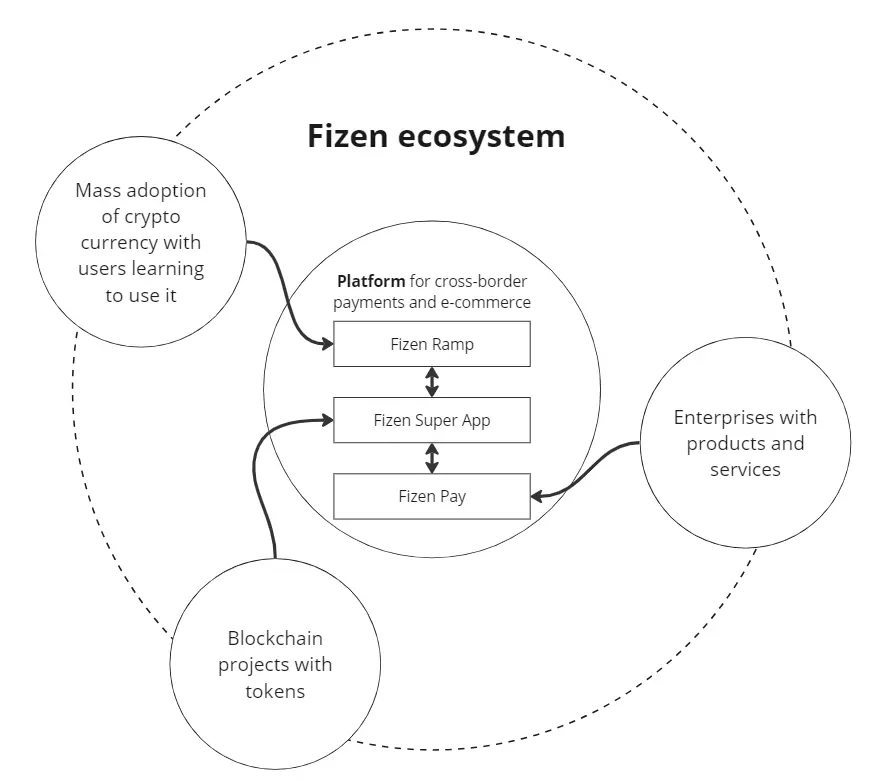
The Fizen ecosystem is a place where individuals and businesses can collaborate to create significant profits.
For Users: Through Fizen Ramp, users can easily buy and sell cryptocurrencies through various methods (such as bank transfers, credit cards, etc.). They can securely store cryptocurrencies on the Fizen super application and use them for payments and shopping.
For Businesses Providing Products and Services: Businesses can easily accept cryptocurrency payments through Fizen Pay, expanding their reach to a global audience, including emerging cryptocurrency users, thereby achieving profit growth. Fizen helps businesses sell goods and services within the Fizen super application.
For Blockchain Projects with Tokens and Coins: Blockchain projects can integrate their tokens and coins into the Fizen super application, allowing users to use these tokens and coins to purchase various goods and services. This significantly enhances the use value of tokens and coins, increases user loyalty, and deepens connections with the projects.
- Fizen Ramp
For new users, one major challenge in purchasing cryptocurrencies is how to operate. Typically, users need to register an account on a cryptocurrency exchange, complete KYC (Know Your Customer) by providing documents such as a passport or ID, and upload a selfie for identity verification. This verification process can take anywhere from 30 minutes to a week. Even when purchasing cryptocurrencies on exchanges, the process may not be straightforward.
Fizen understands the challenges faced by customers and is committed to creating the simplest and optimal experience for them.
- Download the app and create a wallet in 1 minute.
- Purchase cryptocurrencies via bank transfer and receive them within 5 minutes.
Currently, Fizen does not require KYC for small transactions to provide convenience. However, for larger transactions, and to comply with laws and regulations and prevent money laundering, Fizen will conduct KYC verification while prioritizing user-friendliness and convenience.
The Fizen super application is also a non-custodial cryptocurrency wallet, meaning users have complete control over their private keys and assets. Fizen and its employees cannot access users' crypto assets. This differs from users purchasing and storing cryptocurrencies on exchanges, where users face higher risks; if something goes wrong with the exchange, users' assets may be lost, as demonstrated by the bankruptcy of FTX, which resulted in users losing $10 billion in assets.
- Fizen Super App
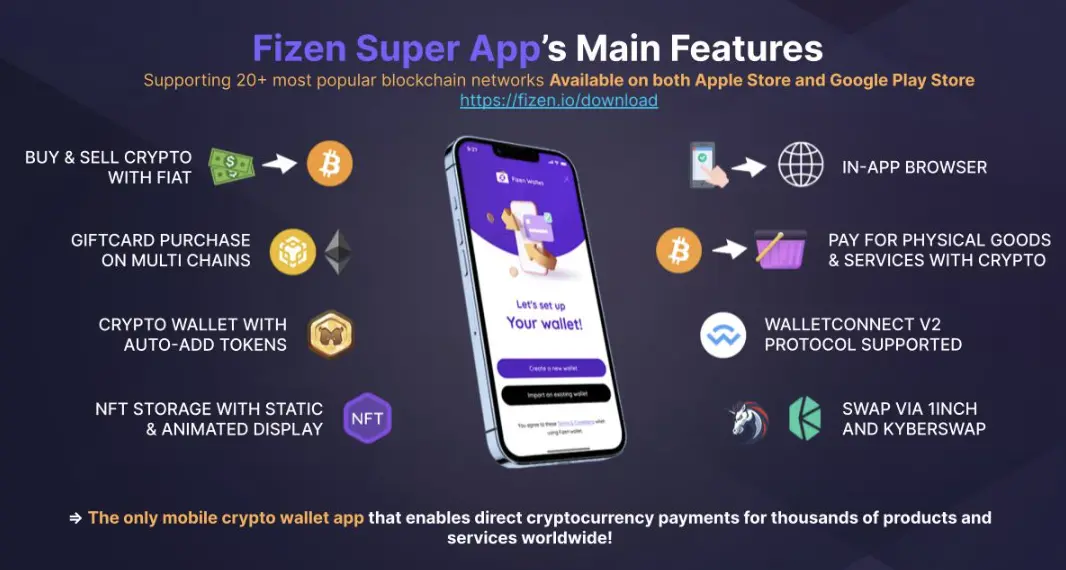
The uniqueness of the Fizen super application lies in its user-friendliness and the numerous practical features that users can immediately utilize in their daily lives. These applications include topping up mobile phone bills, purchasing movie tickets, buying coffee, and more.
User-friendliness is a particularly important feature of the application, as it enables more users to use it, including those unfamiliar with cryptocurrencies. The Fizen super application aims to be a solution that brings blockchain technology and cryptocurrencies to billions of people. To participate, new users no longer need to learn complex terms or technologies like trading or decentralized finance (DeFi). They simply need to buy coffee, earn points, and enjoy discounts.
By introducing everyday applications such as buying coffee, movie tickets, or NFT rewards into the Fizen super application, it will increase the frequency of daily use and help users develop usage habits.
- Fizen Pay Payment Gateway
Information technology is advancing at an unprecedented pace, impacting and transforming various fields. However, the banking and financial industries have been relatively slow to adopt technology. The main reason is the large scale of the system, involving large financial institutions such as banks, credit institutions, and payment companies. When you shop and use cards like Visa or Mastercard, your transactions need to be processed through multiple companies and organizations. At each stage, transaction fees from these institutions accumulate.
To prevent users from feeling the loss, payment institutions typically charge fees to businesses providing goods and services. Naturally, businesses cannot absorb all these costs and instead pass them on to product prices. Therefore, customers may feel that they are not being charged when using traditional payment methods, but in reality, they are indirectly paying these fees through product prices.
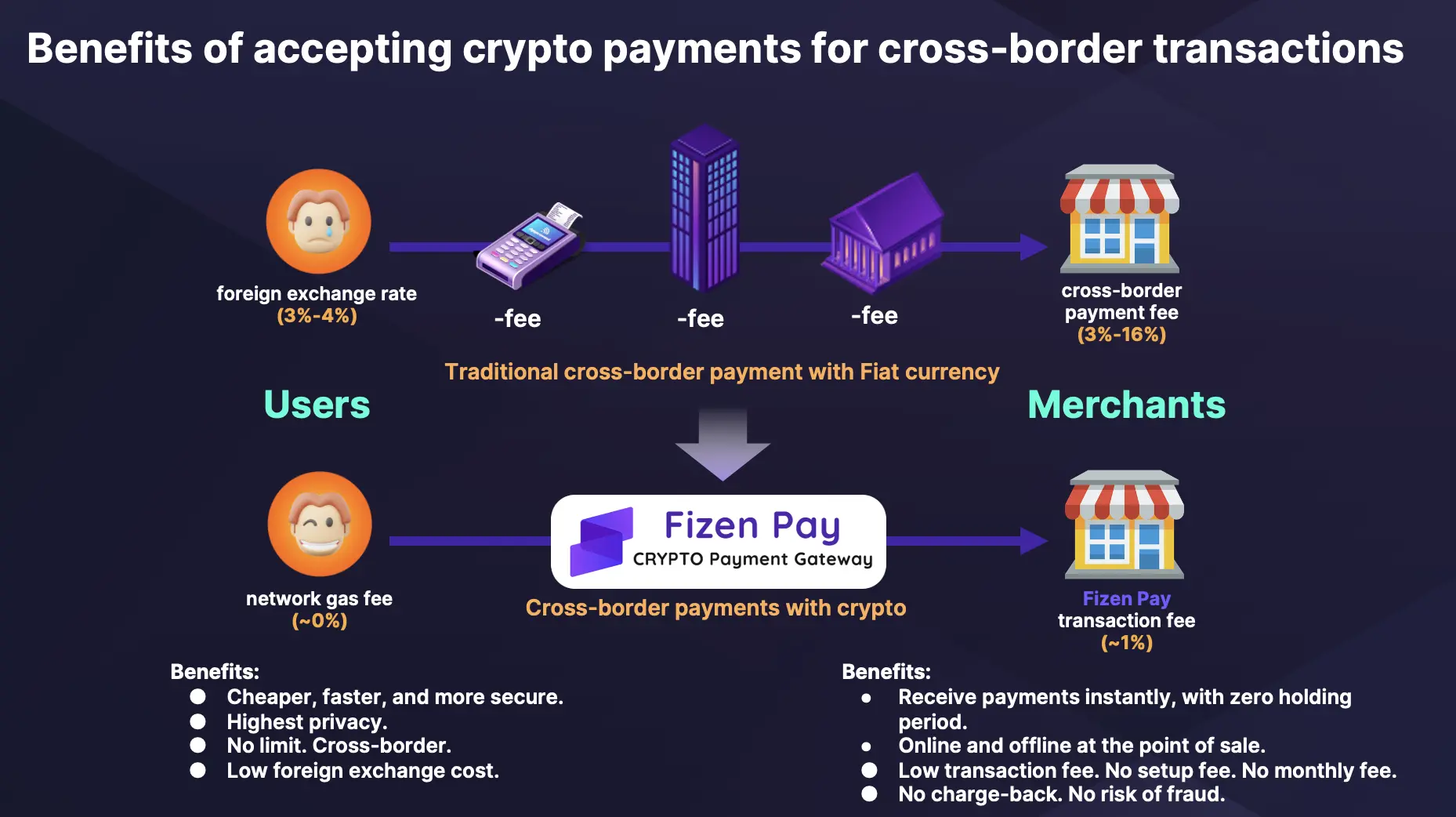
A significant feature of blockchain and cryptocurrency technology is that it provides a peer-to-peer financial system, allowing funds to be transferred directly from one entity to another without intermediaries. This helps reduce payment costs. For businesses to accept cryptocurrency payments, they need a payment gateway. While businesses can build their own payment gateways, this requires a lot of time and effort. Therefore, Fizen offers Fizen Pay, providing businesses with a comprehensive solution with very low transaction fees, below 1%.
With such low transaction fees, businesses can lower product prices, convert them into loyalty points, or offer cash back to customers. Even better, businesses can receive payments instantly without experiencing the delays associated with other payment methods (which typically take 3 to 15 days).
Most importantly, a simple payment gateway solution offers limited help to businesses. Businesses do not know where cryptocurrency users are, and users do not know which businesses accept cryptocurrency payments. This is why Fizen was built as a comprehensive ecosystem. Fizen not only provides technical solutions but also connects businesses with customers.
++Review++
Overall, Fizen has significant advantages in simplifying cryptocurrency transactions, reducing transaction costs, and improving payment efficiency. However, to achieve large-scale user and market acceptance, challenges such as user education, compliance, and market awareness still need to be addressed.
1.2. Understanding How Firefish, a Peer-to-Peer Open Lending Market in the BTC Ecosystem, Creates a Win-Win for Borrowers and Lenders
Firefish is an open lending market that facilitates Bitcoin-backed loans, directly connecting borrowers and investors while avoiding the involvement of intermediaries. Borrowers can obtain fiat or stablecoin loans by using Bitcoin as collateral, thus gaining liquidity without selling their assets. Investors provide funds for these loans and ensure fixed interest returns by having the value of the Bitcoin collateral exceed the loan amount. The platform operates in a peer-to-peer manner, ensuring transparency and security through an on-chain escrow system.
Participants in the Firefish Protocol
- Borrowers: Individuals or entities that own Bitcoin and seek liquidity in fiat currency.
- Lenders: Individuals or entities that have excess liquidity in fiat currency and wish to earn interest.
- Liquidators: Entities appointed by lenders responsible for liquidating collateral on behalf of lenders if borrowers fail to meet their obligations. Lenders can also act as liquidators themselves.
- Price Oracles: Oracles that verify the Bitcoin exchange rate. They can be implemented by trusted institutions, public oracles, or a threshold mechanism composed of multiple institutions and public oracles. Currently, Firefish operates the price oracle.
- Payment Oracles: Oracles that verify whether fiat currency payments have been completed (e.g., loan repayments). Currently, Firefish operates the payment oracle.
- Firefish: A platform that matches borrowers and lenders and facilitates their secure interactions.
++Architecture Overview++
- Escrow Contract
The escrow contract is a core component of the Firefish protocol. It allows Bitcoin collateral to be locked in a specific address, with further operations on the collateral only permitted when the following conditions are met:
- When specific conditions are met (e.g., loan repayment)
- In a specific manner (contract outputs can only be sent to predetermined addresses)
The escrow contract can be illustrated as follows:
++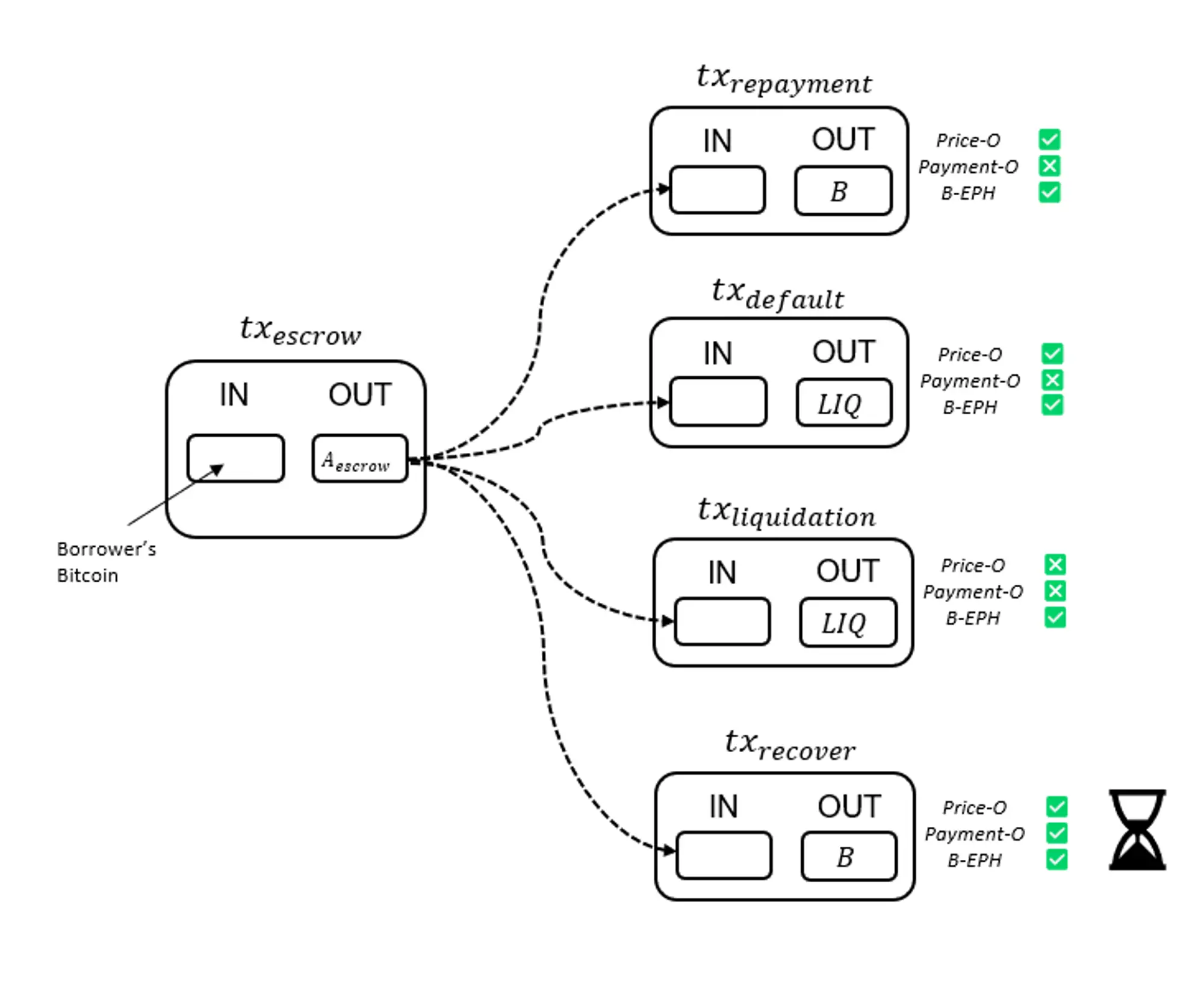 ++
++
The first layer of the escrow contract is the tx_escrow transaction. Its input is the borrower's UTXO (the borrower's Bitcoin), and its output is a 3/3 multi-signature address, with the signing keys held by the following three parties:
- Price Oracle
- Payment Oracle
- Borrower (temporary key), B-EPH
The output of the tx_escrow transaction is the escrow itself, and the Bitcoin will be locked in this address during the loan period.
The second layer of the escrow contract consists of a set of partially signed transactions (PSBTs) that allow the output of tx_escrow to be consumed, i.e., the collateral to be unlocked and sent to the predetermined address. This operation occurs when specific conditions are met (e.g., loan repayment), and the missing signatures are added to the PSBT.
- Prefund Contract The prefund contract is suggested to allow borrowers to conveniently use various Bitcoin infrastructure (hardware wallets, software wallets, custodial wallets) by integrating and confirming the UTXO that will be used to fund the escrow contract through an additional on-chain transaction.
This additional on-chain transaction is called txprefund, which is positioned before the txescrow transaction and can be illustrated as follows:
This structure allows borrowers to easily interact with the Firefish protocol: they send Bitcoin collateral to a specific address A_prefund.
A_prefund represents a complex spending condition:
- 3/3 multi-signature (borrower's temporary key B-EPH, price oracle, payment oracle)
- After a specific time lock, the borrower signs using their temporary key B-EPH
The multi-signature branch is used in the tx_escrow transaction, while the other two options provide additional security and reduce the trust required between parties.
Firefish Protocol, Prefund, and Escrow Contracts:
++ ++
++
- Firefish App
The Firefish protocol aims to minimize risks and reduce reliance on mutual trust between parties. To fully leverage the security of the prefund and escrow contracts, borrowers must be able to construct addresses and transactions or verify that they have been correctly implemented according to the protocol.
To make the protocol accessible to borrowers with different technical levels and using different wallets, the Firefish App was developed. This is a dedicated Bitcoin wallet software with the following features:
- The app is open-source software that borrowers can compile and run on their own hardware (desktop or browser).
- The app can construct complex addresses and transactions according to the Firefish protocol.
- The app generates temporary key pairs, signs transactions, and stores necessary data (e.g., PSBT).
++Review++
Firefish Protocol provides an innovative decentralized loan solution, ensuring transaction security and transparency through smart contracts, escrow contracts, and prefund contracts. However, issues such as technical barriers, oracle dependencies, Bitcoin price volatility, and centralized management of the platform remain potential risks and challenges.
1.3. Analyzing the Features of the Decentralized Communication Protocol Towns, Led by A16z and Co-Invested by Coinbase with $10 Million
The Towns protocol is an open-source protocol for building decentralized real-time messaging applications. It consists of an EVM-compatible L2 chain, decentralized off-chain flow nodes, and smart contracts deployed on Base. Towns allows people to create programmable communication use cases in a permissionless manner, referred to as "Spaces." These spaces are ownable, featuring on-chain subscriptions ("memberships"), a scalable reputation system, and end-to-end message encryption capabilities.
++Feature Analysis++ ++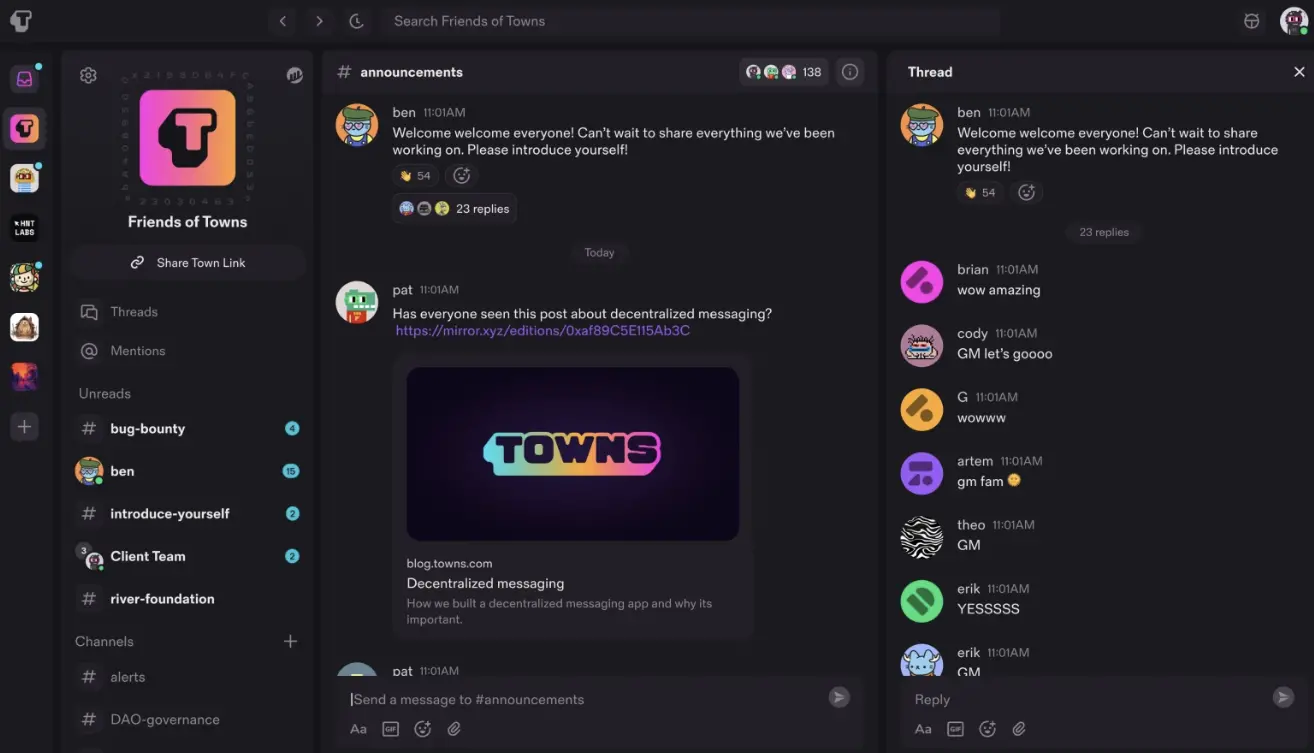 ++
++
- ++Main Features++
- Application Chain Built for Social Networks-- Towns ensures read/write permissions on Base, allowing our application chain to make trade-offs in activity and send messages to thousands of participants as quickly as any existing centralized social network.
- Ownable Communication-- Space creators truly own the spaces they create as on-chain assets.
- Programmable Spaces-- Spaces are deployed on-chain and have programmable interfaces that allow for customized rules (such as who can read and write) and can integrate with any other external EVM-compatible contracts.
- On-Chain Membership and Built-in Protocol Fees-- Users need to hold valid membership tokens to send and receive messages within a space. Membership pricing enforces protocol fees to cover network operating costs.
- On-Chain Social Graph-- Membership tokens and spaces can be discovered on-chain.
- Scalable Reputation System-- Towns' communication spaces can be programmed to allow members to discover peer-based ratings specific to the space on-chain.
- End-to-End Encrypted Messaging-- Advanced encryption technology ensures that messages between senders and authorized users are secure and private.
- ++Towns Smart Contracts++
Towns smart contracts are the cornerstone of the Towns ecosystem, providing a powerful framework for creating, managing, and interacting with digital communities (referred to as "spaces") on the blockchain. These contracts are deployed on the Base mainnet—a Layer 2 solution optimized for scalability and efficiency.
- Unique Contract Address for Each Space
- Unique Operations and Governance: Each space in the Towns ecosystem is equipped with a unique contract address. This personalized approach ensures that each space has distinct operations, governance, and interaction, maintaining its unique identity and operational structure.
- Advantages of Towns Smart Contracts
- Programmability: Towns smart contracts allow every aspect of a space to be fully programmable. Developers can create complex membership restrictions based on token balances, NFTs, or on-chain activities; implement dynamic pricing and automatic subscriptions; deploy bots to enhance community interaction; and seamlessly integrate with other Web3 applications and DeFi protocols, opening new possibilities for on-chain community interaction.
- Scalability and Efficiency: By leveraging Ethereum Layer 2 solutions, Towns smart contracts significantly enhance operational scalability, ensuring that the growing demands of digital communities are met without compromising performance.
- Reduced Transaction Costs: The use of Layer 2 solutions plays a key role in lowering transaction costs, making interactions within the Towns ecosystem more economical for users.
- Enhanced Security and Transparency: Smart contracts themselves provide a secure and transparent framework for digital interactions. The immutability of blockchain technology combined with the transparency of smart contracts creates a trustworthy environment for all users.
- Automated Governance: These contracts facilitate automated governance mechanisms, ensuring that the rules and protocols defined for each space are executed consistently and fairly.
- ++Towns Messaging Protocol++
The Towns messaging protocol is the core infrastructure for verifying and transmitting encrypted messages. It provides an innovative approach to secure and private group messaging. The protocol is designed to run seamlessly within blockchain infrastructure, leveraging the power of decentralized technology to deliver a high-quality permissionless messaging experience.
Read/write permissions are secured on Base, allowing Towns to make activity trade-offs and send messages to thousands of participants as quickly as any existing centralized social network. The Towns protocol was initially built for a wide range of chat application use cases and chat business logic, but in the future, the protocol will be abstracted to form a foundational layer for any form of encrypted messaging use case. Its features include:
- Encrypted Communication
- End-to-End Encryption: The Towns messaging protocol employs state-of-the-art encryption methods to ensure that all communications are secure from end to end. No one, including Towns node operators, can decrypt and read messages within the Towns ecosystem except for the sender and authorized users.
- Privacy Design: The protocol emphasizes user privacy, ensuring that message content is only visible to intended recipients, with no access for anyone else.
- Decentralization
- Distributed Network: The protocol operates on a distributed network of nodes, ensuring reliability and protecting against risks of centralized failure points.
- User Autonomy: Spaces within the protocol are governed by users, fostering a community-driven environment where users can control their communication channels.
- Scalability and Efficiency
- Scalable Architecture: Designed to handle a large volume of messages without compromising speed or security.
- Resource Optimization: Efficiently utilizes network resources, ensuring the sustainability and cost-effectiveness of the protocol.
- Components
- Towns Chain: A Layer 2 blockchain solution that supports the Towns messaging protocol, providing consensus and security.
- Flow Nodes: Nodes responsible for managing the flow of messages within the protocol, handling tasks such as message verification, storage, and encryption.
- Permission Management: Manages user permissions and access within spaces, ensuring a secure and orderly communication environment.
++Review++
The Towns protocol offers users a secure and flexible communication platform through decentralization, privacy protection, and efficient messaging capabilities, particularly suitable for social applications that require high privacy guarantees. However, its reliance on blockchain, cost issues, and governance structure challenges also need to be considered in practical applications.
## 2. Detailed Overview of Projects to Watch This Week
2.1. Detailed Analysis of OpenZK, a Layer 2 Network Built on ZK Rollup Technology, Raised $6 Million from Animoca, Allowing Native Tokens to Pay Gas Fees
++Introduction++
OpenZK is a Layer 2 solution based on zero-knowledge Rollup (ZK Rollup) technology, aimed at addressing Ethereum's scalability, cost, and performance limitations while maintaining its security guarantees. OpenZK provides an efficient, secure, and low-cost transaction processing environment, particularly suitable for decentralized finance (DeFi), real-world assets (RWA), NFTs, and trading applications.
ETH Staking and Rewards One of the core innovations of the OpenZK network is its native ETH staking mechanism, allowing users to bridge ETH to the network while earning Ethereum staking and restaking rewards without additional operations, thereby contributing to the stability and security of the Ethereum ecosystem.
This native staking mechanism is seamlessly integrated into OpenZK's architecture; once users bridge their ETH to OpenZK, it is immediately staked/restaked, generating rewards instantly, and users will receive liquid tokens (ozETH) representing their staked/restaked ETH positions and related rewards.
Stablecoin Rewards OpenZK also includes a native stablecoin reward and incentive feature, allowing users to earn additional rewards on their stablecoin holdings. The design of stablecoin-related rewards is simple and user-friendly. Users can bridge certain stablecoins (such as USDT, USDC, DAI, or other supported assets) to the OpenZK network, and these assets will automatically participate in L1 non-custodial savings mechanisms (such as MakerDAO/sky.money), generating reference tokens and related rewards (ozUSD) for that position without requiring additional user operations or complex steps.
OZK Token OZK is the protocol token of the OpenZK network, designed to provide utility and governance functions. It will play a significant role in driving the network, facilitating transactions, and aligning incentives within the ecosystem. Users can use ozETH and the anticipated future OZK to pay gas fees on the network, supporting the basic utility of OZK.
OpenZK will adopt a non-inflationary token model. It is expected that, where applicable and based on community governance decisions, a portion of gas fees paid in OZK may be removed from supply and allocated to pools for community/ecosystem initiatives.
++Technical Analysis++
- ++ETH Staking and Restaking++ The Liquidity Manager contract is an ERC20 standard-compliant smart contract used to manage liquidity allocation in multiple vaults through a weighted system. Users can deposit "staked" native ETH into the Liquidity Manager contract to receive an ozETH ERC20 token in return.
The underlying asset in the Liquidity Manager contract is native ETH.

Core Contracts
- ozETH Token
- Liquidity Manager
- Rocket Pool Vault
- Restaking Contract via EigenLayer
- Price Oracle
Liquidity Manager Contract
The Liquidity Manager serves as the central controller of the entire system, responsible for the following tasks:
- Asset Allocation
- Manage the allocation of ETH across multiple Vaults.
- Implement a weighted allocation system.
- Issue shares representing users' proportional interests.
- Vault Management
- Maintain a registry of supported Vaults.
- Control the addition and removal of Vaults.
- Manage the weight of Vaults for deposit allocation.
- Handle deposit and withdrawal interactions with Vaults.
- Share Tokenization
- Issue ERC20 tokens representing user deposits.
- Calculate shares based on Vault performance.
- Handle share destruction upon withdrawal.
Vault Contract (Rocket Pool)
The Vault is a contract specifically interfacing with a particular staking protocol:
Protocol Integration
- Implement deposit/withdrawal logic for specific protocols.
- Manage conversions between ETH and protocol tokens.
- Handle protocol-specific staking mechanisms.
Asset Management
- Hold and manage protocol-specific tokens.
- Track asset balances and share calculations.
- Implement security checks and withdrawal restrictions.
Restaking Contract
The restaking contract is used to allocate shares from the Vault contract to other staking/restaking protocols, such as EigenLayer. In this case, shares in the Vault become assets. Restaking is an optional feature of the Vault, maintaining a 1:1 relationship, while the Vault can only restake shares to one restaking protocol.
Price Oracle
When the protocol needs to convert the price of assets or shares to local ETH, it calls the price oracle and returns the price via Uniswap v3.
++System Flow++
Deposit Process
- Users deposit ETH into the Liquidity Manager.
The Liquidity Manager:
- Calculates allocation based on Vault weights.
- Distributes deposits to registered Vaults.
- Issues shares to represent users' deposits.
- Each Vault:
- Receives a portion of ETH.
- Converts ETH into protocol-specific tokens.
- Updates internal accounting.
- Reports to the Liquidity Manager.
Withdrawal Process
- Users initiate a withdrawal request using shares.
The Liquidity Manager:
- Calculates proportional withdrawals from each Vault.
- Coordinates withdrawal requests.
- Destroys users' shares.
- Each Vault:
- Converts protocol tokens back to ETH.
- Handles any protocol-specific un-staking operations.
- Returns ETH to the Liquidity Manager.
- The Liquidity Manager returns the merged ETH to the user.
- ++Stablecoin Staking++
The protocol allows users to deposit and "stake" their stablecoins (such as USDT, DAI, USDC, etc.) through sky.money's non-custodial savings mechanism, receiving liquid tokens (ozUSD) representing that position.
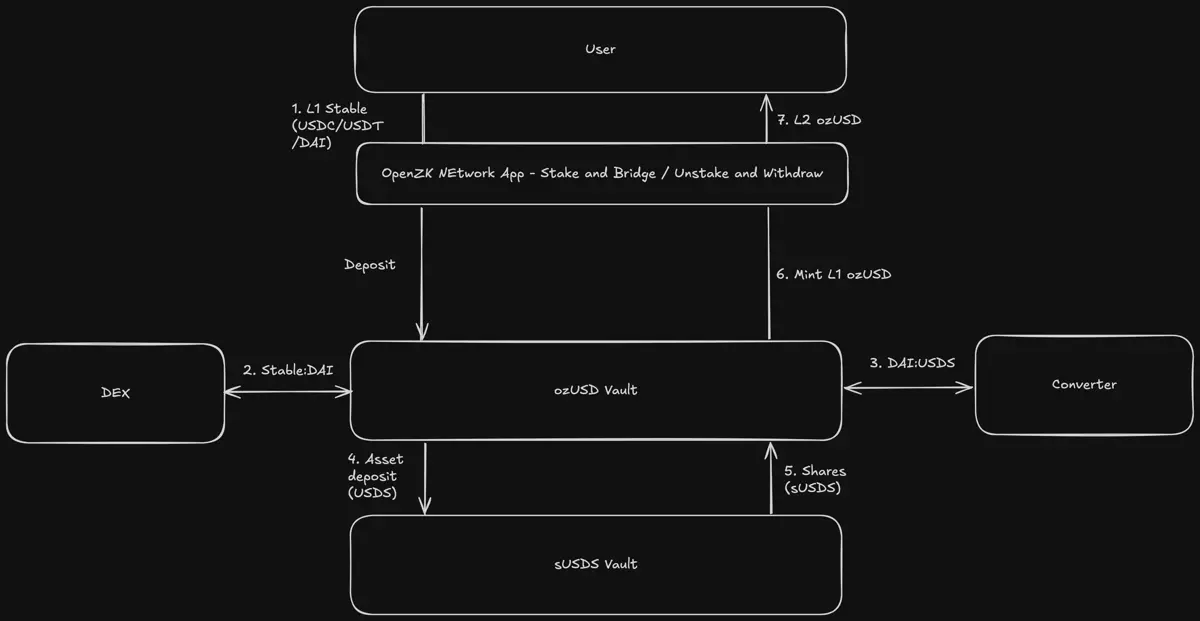
Core Contract
- ozUSD Vault
- The ozUSD Vault contract allows users to deposit specific tokens, which are exchanged for USDS through Sky Money's "converter" contract.
++System Flow++
Deposit Process
- Users deposit allowed stablecoin assets into the ozUSD Vault contract.
- If necessary, assets will first be exchanged for DAI through the UniSwap v3 router (following defined slippage limits) and then converted to USDS through the Sky Money Converter.
- The conversion rate is 1:1 (DAI:USDS).
- The received USDS will be deposited into the sUSDS Vault. The shares obtained (sUSDS) will be stored in the ozUSD Vault contract, and for each sUSDS share held, one ozUSD will be minted in the ozUSD Vault.
Withdrawal Process
- Users can withdraw/un-stake by destroying ozUSD and automatically redeeming the underlying stablecoin and accumulated rewards for each sUSDS. Users can initiate this process by calling the QueueWithdraw function.
- Users will receive a nonce, which will be used to complete the withdrawal after the cliff period ends.
- Each ozUSD is destroyed and redeemed for its corresponding sUSDS and underlying stablecoin assets, which are then automatically exchanged for the stablecoin of the user's choice through the ozUSD Vault and Uniswap, and held in the ozUSD Vault.
- Once the cliff period ends, users can complete the withdrawal by executing the Withdraw function with the provided nonce.
++Summary++
OpenZK provides a decentralized and automated stablecoin staking solution that enhances liquidity and brings additional rewards, but it also faces challenges such as risks associated with reliance on external tools, slippage and fee issues, and delays in the withdrawal process. This system offers significant advantages for users focused on decentralization, liquidity, and automation, but may present limitations for those requiring high flexibility and instant withdrawals.
# III. Industry Data Analysis
1. Overall Market Performance
1.1 Spot BTC & ETH ETF
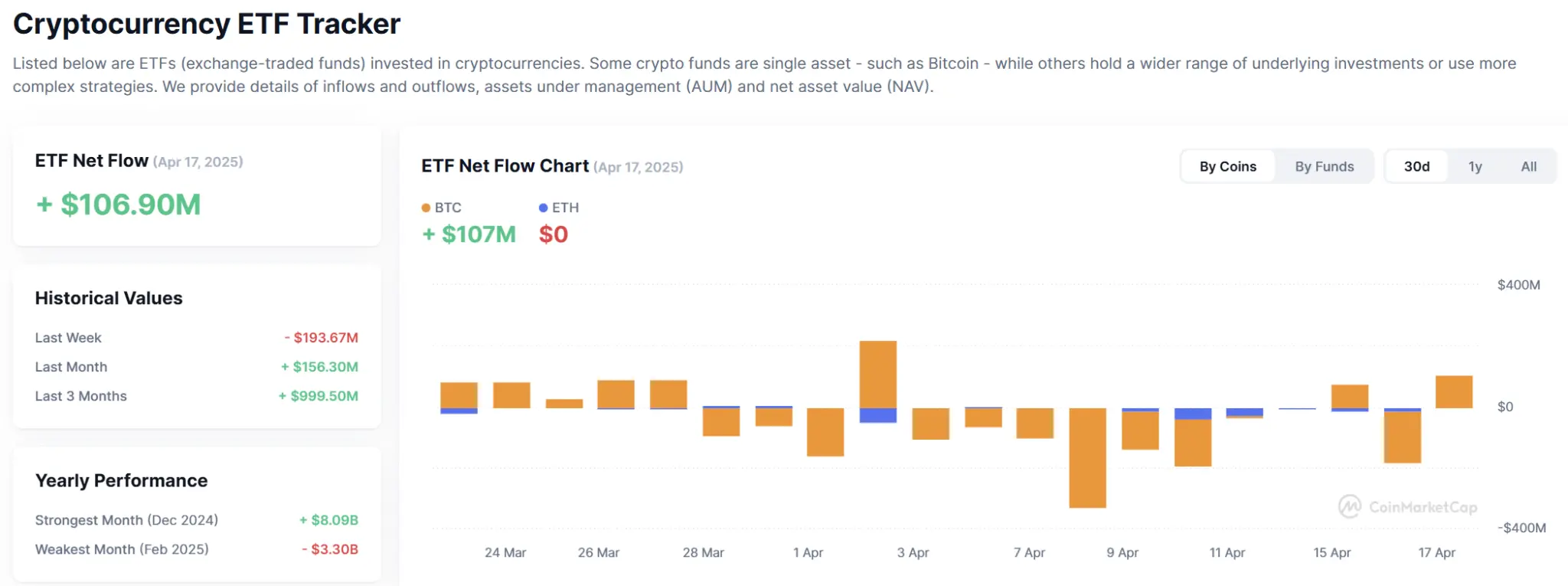
As of November 1 (Eastern Time), the total net outflow of Ethereum spot ETFs was $10.9256 million.
1.2. Price Trends of Spot BTC vs ETH
BTC
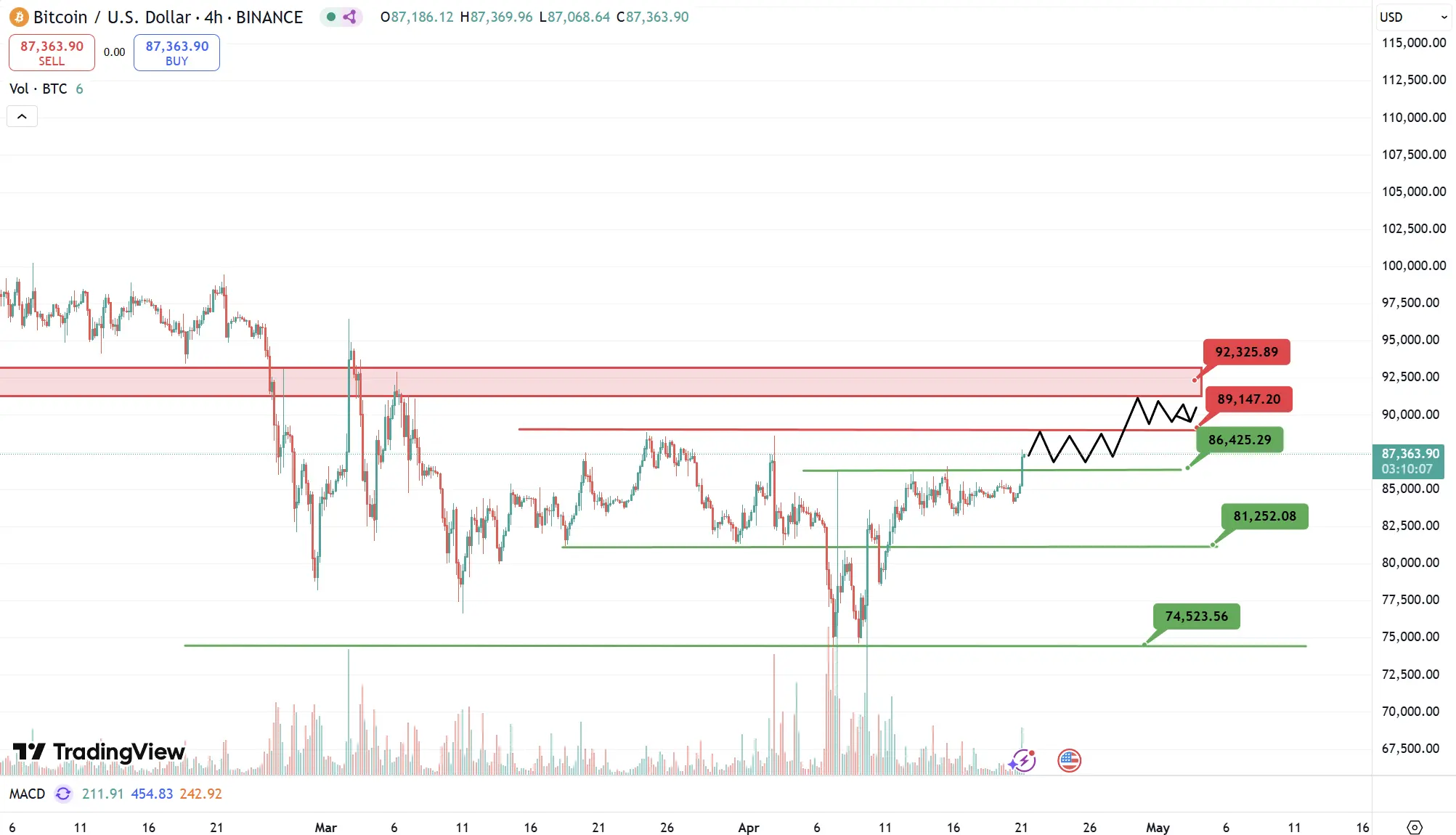
Analysis
BTC continued to rebound as expected after a narrow consolidation in the $83,000~$86,000 range last week, with a significant increase in volume at the beginning of this week. Before testing the resistance zone around $89,100, the bulls faced little resistance, and given the stabilization of the fundamentals, there are sustained reasons for the rebound momentum. Therefore, this week, users can directly focus on the strong resistance at $89,100. If sufficient upward momentum accumulates in the $86,400~$89,000 range during the first half of this week and breaks through with volume, it can continue to rise to the secondary resistance at $92,000 (as shown). Conversely, if an upward spike occurs during the breakout and volume quickly shrinks, it may indicate exhaustion of upward energy, and the price will continue to oscillate within the $81,000~$89,000 range on a weekly basis.
ETH
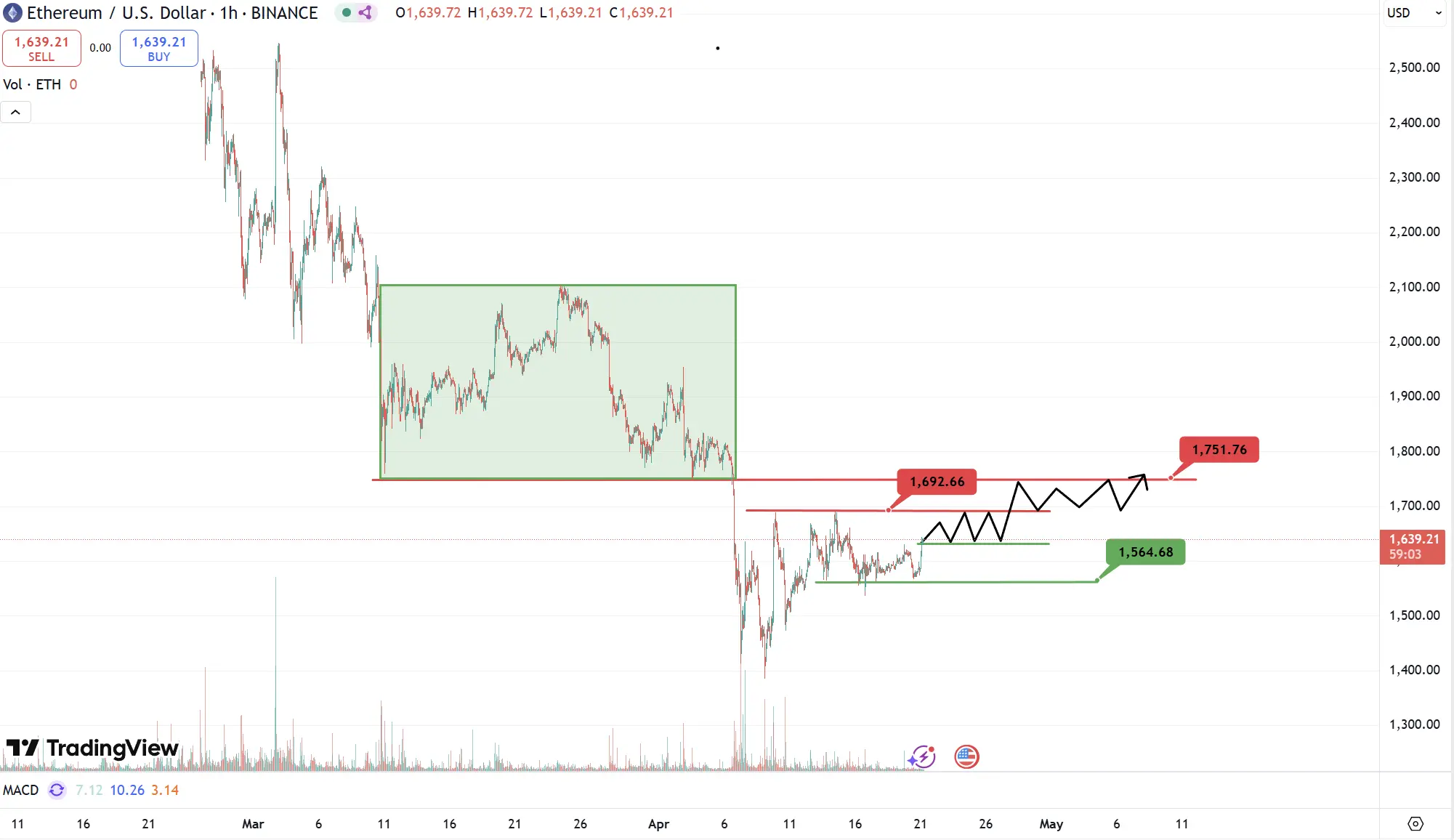
Analysis
After stabilizing at $1,560, ETH has not yet effectively broken through the short-term key resistance at $1,630, but as the fundamentals gradually improve, a slow upward trend is highly likely. This week, users can directly focus on the strong resistance at $1,690. If it breaks through, it will directly look towards the secondary resistance at $1,750 (the lower boundary of the green consolidation zone), which may be a recent area that bulls find difficult to surpass.
As for support, attention can be temporarily focused on the vicinity of $1,560. If it does not break below this point, the outlook remains bullish; if it breaks, it indicates that the bottoming trend continues.
1.3. Fear & Greed Index
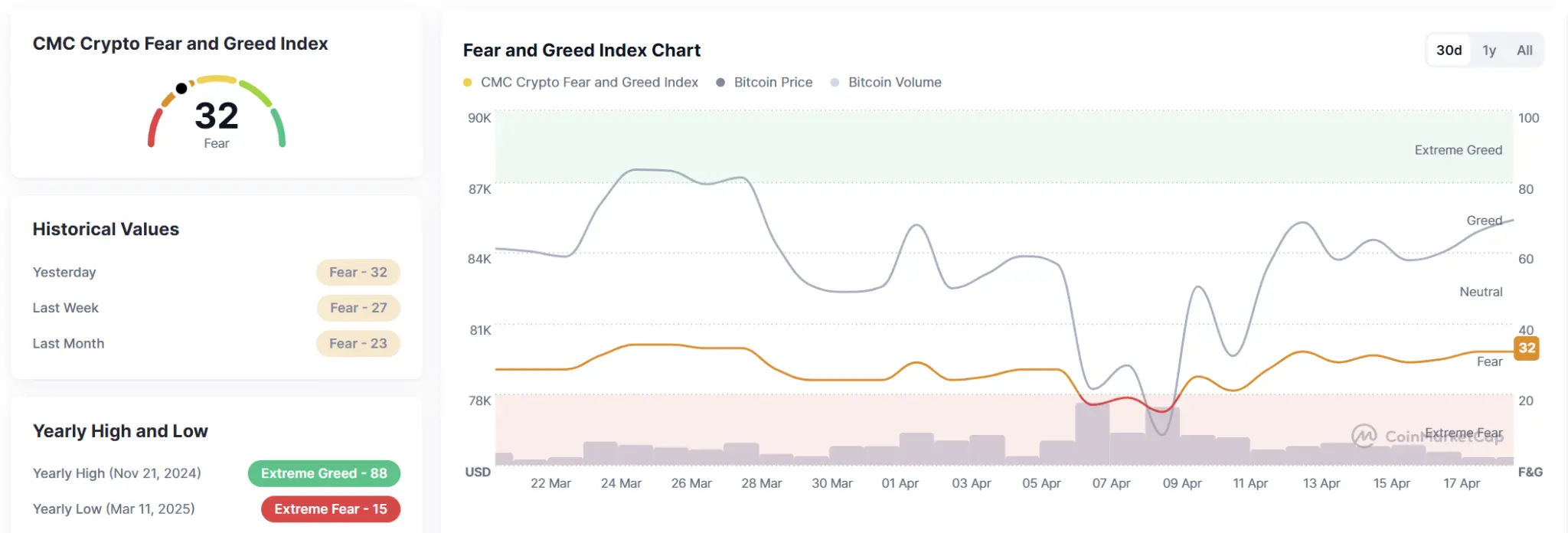
2. Public Chain Data
2.1. BTC Layer 2 Summary

Analysis
- Merlin Chain ($MERL) Token Launch
Merlin Chain is one of the leading Bitcoin L2 protocols, launching its native token $MERL on April 19. The protocol's total locked value (TVL) has exceeded $3.6 billion and covers over 200 decentralized applications (dApps) across DeFi, gaming, and social platforms. The $MERL token will be used for protocol governance, staking, and transaction fee payments. The token has been listed on major exchanges, including OKX and Bitget, demonstrating strong community support and institutional confidence.
- Stacks (STX) Nakamoto Upgrade
Stacks activated its Nakamoto upgrade in late April, enhancing transaction finality and reducing block time to about five seconds. This upgrade supports the upcoming sBTC (an asset pegged to Bitcoin), facilitating smoother integration of decentralized finance (DeFi) applications between Bitcoin and Stacks.
- BitVM and Bitlayer Innovations
Bitlayer introduced BitVM, a computational model that combines optimistic Rollup and Bitcoin's scripting capabilities, enabling fraud proofs on Bitcoin. This innovation allows for complex smart contracts to be implemented without changing Bitcoin's underlying structure, attracting projects such as decentralized exchanges (DEX) and AI-based protocols.
- Union Bridge Protocol
The Union protocol is a trust-minimized bridging protocol designed for Rootstock, making BTC transfers between Bitcoin and other Layer 2 blockchains secure. By adopting a multi-party variant of BitVMX, the Union protocol can provide scalable Bitcoin interoperability solutions under the assumption that at least one participant remains honest.
2.2. EVM & Non-EVM Layer 1 Summary
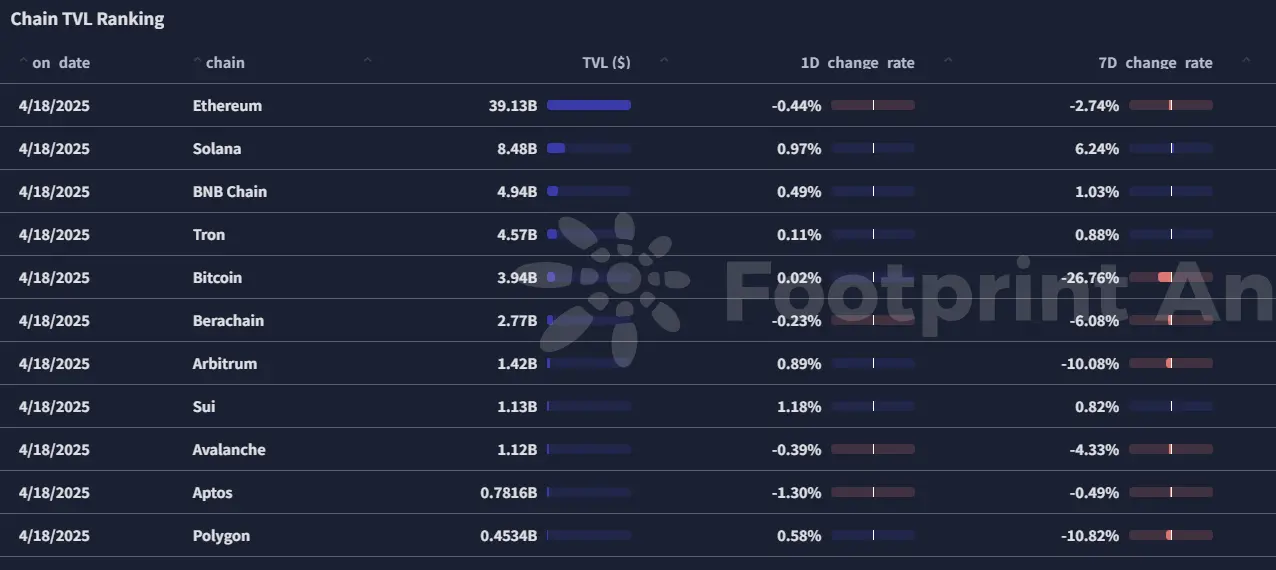
Analysis
++EVM-Compatible Layer 1 Blockchain Dynamics++
- EOS EVM Mainnet Launch
The EOS Network Foundation successfully launched its EVM mainnet on April 14, aiming to combine its performance with Ethereum compatibility. The EOS EVM's throughput exceeds 800 swaps per second, three times that of Solana and 25 times that of Avalanche, providing developers with an efficient development platform.
- Polkadot 2025 Roadmap Release
Polkadot announced plans to support EVM and Solidity in 2025, adopting a multi-core architecture to enhance scalability and upgrading the cross-chain messaging protocol through XCM v5 to improve interoperability. Additionally, Polkadot will simplify address management, shorten DOT unlocking times, and support Rollup fee payments.
- Injective Introduces EVM Compatibility
The Layer 1 blockchain Injective from the Cosmos ecosystem announced native support for EVM, allowing Ethereum-compatible DApps to run on its network. This feature is currently under development and is expected to launch on the mainnet by the end of 2025.
++Non-EVM Layer 1 Blockchain Dynamics++
- Solana Transaction Throughput Improvement
Solana's non-voting transaction throughput is expected to exceed 5,000 transactions per second by 2025, growing 6-7 times from current levels. Major upgrades include the full deployment of the Firedancer client, optimization of the core Anza client, and more efficient fee markets and program compression solutions to enhance on-chain resource utilization.
- Avalanche9000 Upgrade
Avalanche announced the Avalanche9000 upgrade, expected to reduce Layer 1 deployment costs by 99.9% and lower C-chain transaction fees by 25 times. This upgrade aims to enhance the network's applications in tokenized assets, DeFi, gaming, and more.
- N1 Blockchain Mainnet Launching Soon
N1 is a low-latency, high-throughput Layer 1 blockchain that supports multiple programming languages (such as TypeScript, Python, C, etc.), aiming to provide developers with an efficient platform for decentralized application development. N1 has also launched NTS (TypeScript smart contract development environment), NordVM (Rust-based order book framework), and N1 Studios (application incubation platform) to promote ecosystem development.
2.3. EVM Layer 2 Summary

Analysis
- Key Steps Towards Ethereum L2 Interoperability
The Ethereum community is actively advancing a unified standard for L2 interoperability. Among them, ERC-7683 (Cross Chain Intents) is seen as a key advancement. This standard aims to simplify cross-chain transaction processes, allowing users to seamlessly transfer assets and governance votes between different L2s. Multiple projects, including Polygon, Arbitrum, Optimism, Base, and Uniswap, have expressed support for this standard. Cross-chain transactions are expected to become more straightforward in the coming months.
- Vitalik Buterin Proposes "Embedded zkEVM" Concept
Ethereum co-founder Vitalik Buterin proposed a new zkEVM architecture aimed at directly integrating zkEVM into the Ethereum main chain to improve verification efficiency and security. This proposal could have far-reaching implications for existing L2 projects such as Polygon, Matter Labs, and Scroll.
- Emerging L2 Project InfinixChain Launches
InfinixChain is a new EVM-compatible L2 blockchain designed to enhance scalability, reduce transaction costs, and improve transaction speeds. The project supports decentralized applications in DeFi, NFTs, and GameFi, providing high throughput and low-latency transaction experiences. Currently, InfinixChain has launched a token presale and plans to introduce a native token in the future.
- L2BEAT Strengthens L2 Security Standards
L2BEAT announced that it will implement stricter security standards for L2 projects. Projects that fail to provide sufficient data availability guarantees or prove system integrity will be reclassified as "others." All L2 projects must meet new requirements by mid-2025, or they may face reclassification.
- Ethereum L2 Unified Upgrade to be Completed by 2025
The Ethereum community plans to complete a unified upgrade for L2 by 2025, enabling seamless interoperability between different L2 platforms. This will facilitate cross-chain operations for decentralized applications across multiple L2 networks, enhancing the overall efficiency and user experience of the Ethereum ecosystem.
# IV. Macroeconomic Data Review and Key Data Release Points for Next Week
In March 2025, U.S. retail sales increased by 1.4% month-on-month, exceeding market expectations of 1.3% and February's 0.2%, marking the largest single-month increase since January 2023. As of the week ending April 12, the number of initial jobless claims in the U.S. recorded 215,000, dropping to a new low since the week of February 8, 2025, lower than the market expectation of 225,000 and the previous value of 223,000.
Important macro data points for this week (April 21-25) include:
April 24: U.S. initial jobless claims for the week ending April 19
April 25: Final value of the University of Michigan Consumer Sentiment Index for April
# V. Regulatory Policies
United States
- IRS DeFi Broker Rules Overturned: President Trump signed a bill that repealed the IRS's revised rule that classified decentralized exchanges (DEX) as brokers, thus requiring them to conduct tax reporting. This move aims to reduce the regulatory burden on DeFi platforms.
- Establishment of Strategic Bitcoin Reserves: An executive order created a strategic Bitcoin reserve, with approximately 200,000 BTC confiscated by the Treasury injected into it. This reserve aims to enhance the digital asset sector and address the policies of the previous administration.
- SEC Plans to Hold Cryptocurrency Roundtables: The U.S. Securities and Exchange Commission (SEC) announced it will hold four roundtables to discuss cryptocurrency trading, custody, tokenization, and decentralized finance (DeFi), aiming to establish a regulatory framework for digital assets.
European Union
- European Central Bank Developing Digital Euro: In response to concerns over U.S. stablecoin policies, the European Central Bank is developing a digital euro to enhance payment independence and protect fiat currency.
China
- Debate on Seized Crypto Assets: China is debating how to manage cryptocurrencies seized from criminal activities. Proposals include centralized management and judicial confirmation of the nature of cryptocurrencies as assets.
South Korea
- Crackdown on Unregistered Exchanges: The Financial Intelligence Unit (FIU) is enforcing actions against unregistered overseas cryptocurrency exchanges, including BitMEX and KuCoin, to promote compliance.
Italy
- Concerns Over U.S. Stablecoin Policies: Italian Economy Minister Giancarlo Giorgetti expressed concerns that U.S. policies on dollar-pegged stablecoins could undermine the euro's position and affect Europe's monetary sovereignty.
Pakistan
- Launch of Cryptocurrency Committee: Pakistan has established a cryptocurrency committee aimed at regulating and promoting the domestic cryptocurrency market, enhancing remittance services, and protecting users from fraud.
Australia
- Introduction of Cryptocurrency Regulatory Framework: The Australian government plans to introduce a cryptocurrency regulatory framework in 2025, requiring exchanges and custodial services to comply with existing financial services laws.









